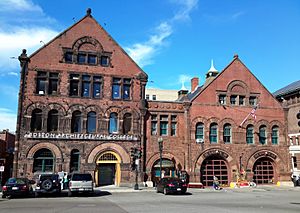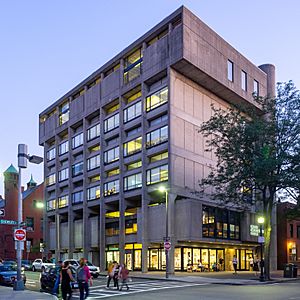Boston Architectural College facts for kids
 |
|
|
Other name
|
The BAC |
|---|---|
|
Former names
|
Boston Architectural Club (1889-1944) Boston Architectural Center (1944-2006) |
| Type | Private college |
| Established | December 11, 1889 (as the Boston Architectural Club) |
| Accreditation | NECHE |
| Endowment | $11.8 million (2019) |
| President | Mahesh Daas |
|
Academic staff
|
300 educators and professional practitioners |
| Students | 700 degree students 300 continuing education students |
| Location |
,
,
United States
42°20′53″N 71°05′09″W / 42.34792°N 71.08585°W |
| Campus | Urban, non-residential, 175 acres (71 ha) |
| Colors | |
| Affiliations | Professional Arts Consortium |
The Boston Architectural College (often called The BAC) is a private college located in Boston, Massachusetts. It is the largest private college in New England that focuses on spatial design. This means it teaches students how to design spaces like buildings, rooms, and landscapes. The college's main building is at 320 Newbury Street in Boston's Back Bay neighborhood.
Contents
History of The BAC
The Boston Architectural College has a long and interesting history. It started as a club and grew into a full college.
Early Years: Boston Architectural Club (1889–1944)
The Boston Architectural Club was founded on December 11, 1889. Its goal was to bring together people interested in architecture. They wanted to help each other learn and share ideas. Members of the club, who were often experienced drafters, taught evening classes to younger drafters. This led to an informal teaching style, much like the famous École des Beaux-Arts in France. The Club also held public art shows and published catalogs of their work.
In 1911, the club bought a building at 16 Somerset Street. This new building had a large Great Hall, designed by Ralph Adams Cram. It also had spaces for lectures, meetings, and studios. These better facilities attracted more students, and the teaching became more organized.
By the 1930s, many American architecture schools started to create their own teaching methods. The Club faced challenges during this time. Arcangelo Cascieri became the dean and helped the BAC change while keeping its unique teaching style. The college began to get teachers from other local architecture schools and design professionals.
Growing Up: Boston Architectural Center (1944–2006)
In 1944, the Club changed its name to the Boston Architectural Center. Its new goal was to teach architecture and related subjects. It especially helped those who worked during the day and could not attend regular day schools.
By 1965, the BAC had grown so much that the Somerset Street building was too small. The college bought a new building at 320 Newbury Street. A design competition was held in 1964, and the winning design was a Brutalist style building. This building is still the main home of The BAC today.
Becoming a College: Boston Architectural College (2006–Present)
On July 1, 2006, the Boston Architectural Center officially became the Boston Architectural College. This new name helped people understand that it was a college that gives out official degrees in architecture and design.
In 2007, The BAC bought another building at 951/955 Boylston Street. This building used to be home to the Institute of Contemporary Art, Boston. It now has studios, a lecture hall, and a gallery space. The building was originally a police station built in 1887. It now has a new entrance that is easy for everyone to use.
What Students Learn: Academics at The BAC
The Boston Architectural College has four main schools:
- School of Architecture
- School of Interior Architecture
- School of Landscape Architecture
- School of Design Studies
The college also offers classes through its Sustainable Design Institute and Continuing Education program.
Sustainable Design Institute
The Sustainable Design Institute (SDI) offers online courses about sustainable design. These courses teach students how to design buildings and spaces in ways that are good for the environment. Students can earn certificates in this field. Many courses count towards continuing education for architects and green building professionals.
Landscape Institute
The Landscape Institute offers classes in landscape design. This includes learning about the history of landscape design, how to preserve old landscapes, and how to plan plants. It is the oldest program of its kind.
This program started at Radcliffe College in 1970. It later moved to Harvard University's Arnold Arboretum and then became part of The BAC in 2009. The Landscape Institute still works with the Arnold Arboretum and other historical organizations.
Continuing Education Programs
The BAC offers many continuing education courses in different design areas. These courses help professionals keep their skills sharp and learn new things.
First Year Program
The Academic-Only First Year Program is an optional program for new students. It helps them build a strong foundation in design studies across all four schools.
Accreditation: Official Recognition
The BAC is officially recognized by several important groups. This means its degrees are valid and respected.
- New England Association of Schools and Colleges (NEASC)
- National Architectural Accrediting Board (NAAB) for architecture degrees
- Council for Interior Design Accreditation (CIDA) for interior design degrees
- Landscape Architectural Accreditation Board (LAAB) for landscape architecture degrees
The BAC is also a member of the ProArts Consortium, a group of art and design colleges.
Campus Life and Buildings
The buildings at The BAC are known by their street addresses. The college is working on making its buildings and the surrounding area more sustainable. This includes reducing rainwater runoff and using geothermal energy. They also plan to improve the public alley between their main buildings.
The BAC does not have student dormitories. Students usually live off-campus.

320 and 322 Newbury Street Buildings
The building at 320 Newbury Street was designed in 1966. It was renovated in 2000. The design of the building makes it look strong and alive. It has open studio floors where students can see into other classes. The ground floor is open to Newbury Street, inviting the public into the McCormick Gallery.
The college bought the building next door at 322 Newbury Street in 1987. This building was once a carriage house built in 1899. Its inside was changed to create administrative offices for the college.
On the side of the 320 Newbury Street building, there is a large mural by artist Richard Haas. It was finished in 1975. This trompe-l'œil mural looks like a classical building with a dome. It creates an interesting contrast with the modern style of the building.
McCormick Gallery: Art for Everyone
The BAC has a gallery called the McCormick Gallery on the main floor of its 320 Newbury Street building. This gallery shows student work and other design exhibits. It is free and open to the public. It is easy to find at the corner of Newbury Street and Hereford Street.
Student Life and Activities
Students at The BAC can join many different groups and activities.
Student Organizations
- AIAS: This is a student-run group for architecture students. It helps students connect, share ideas, and learn through lectures, trips, and community service.
- Student Government Association (SGA): The SGA helps students talk with the college leaders. It also promotes student activities and helps students work together.
- Interior Architecture Collaborative: This group helps interior architecture students. It connects them with professional organizations and offers learning opportunities outside of class.
- NOMAS: This group promotes diversity in architecture. It helps students get involved in design competitions and mentor high school students.
- Photo Club: This club helps students improve their photography skills. They offer workshops and trips to galleries.
- SASLA: This group connects landscape architecture students to each other and to the wider community.
- Studio Q: This is a resource for the college's lesbian, gay, bisexual, transgender, and questioning (LGBTQ) community. It aims to strengthen the LGBT community through social events and activism.
College Traditions
- The Bee: The bee is an informal mascot of The BAC. This comes from a sculpture by Dean Arcangelo Cascieri called Selfless Labor. It shows bees working together in a beehive. The bee symbol is on the college's class ring and is the name of the BAC's running club, the BAC Bees.
Famous People from The BAC
Many talented people have been part of the Boston Architectural College.
- Walter Atherton, an architect
- Maya Bird-Murphy, a modern architectural designer and teacher
- Arcangelo Cascieri, a sculptor and former dean
- Charles L. Fletcher, an architect and interior designer
- Buckminster Fuller, a famous American architect, inventor, and futurist
- Glenn Gissler, an American interior designer
- Wallace Harrison, a 20th-century American architect
- William Sutherland Maxwell, a Canadian architect
- Louis Skidmore, who helped start the famous firm Skidmore, Owings & Merrill
- Edward Durell Stone, a 20th-century American architect
- Stewart Wurtz, a studio furniture maker
See also
 In Spanish: Colegio de Arquitectura de Boston para niños
In Spanish: Colegio de Arquitectura de Boston para niños
- 941–955 Boylston Street
- Boston Society of Architects
- Spatial design
- Architecture of Boston


